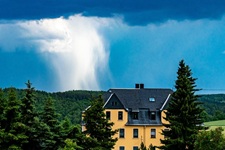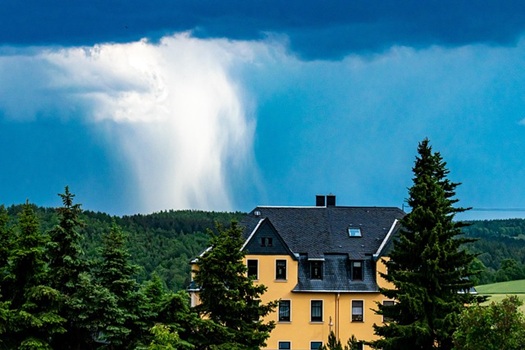What Is a Cloudburst and Why Is It Dangerous? Explained

What Is a Cloudburst and Why Is It Dangerous? Explained
Imagine a sudden downpour so intense it turns streets into rivers in minutes. A cloudburst is exactly that—an extreme weather event where heavy rain falls in a short time, often causing chaos. But what causes this cloudburst weather phenomenon, and why is it so dangerous? Join us at omnimyths.com to dive into the science, impacts, and safety tips for this wild natural event!
What Exactly Is a Cloudburst?
A cloudburst is a sudden, intense rainfall where a massive amount of water—often inches in hours—pours from the sky.
Cloudbursts happen when warm, moist air rises rapidly in unstable atmospheric conditions, forming towering cumulonimbus clouds packed with water. These clouds “burst,” releasing rain at rates exceeding 100 mm per hour, far heavier than typical storms (NOAA, 2023). Unlike steady rain, cloudbursts are brief but ferocious, often lasting less than an hour. They’re common in mountainous areas, like the Himalayas or the Rockies, where terrain forces air upward, triggering the deluge (University of Colorado, 2022).
Think of Priya, a hiker in northern India, caught in a 2024 cloudburst that dumped 4 inches of rain in 30 minutes. Her peaceful trek turned into a scramble to avoid flooding streams. This intensity defines the cloudburst explained, a phenomenon that’s both awe-inspiring and terrifying.

The Science Behind Cloudbursts
How does a cloudburst form? It’s all about atmospheric chaos meeting geography.
Warm air, laden with moisture from oceans or rivers, rises quickly when heated or pushed by terrain like mountains. As it cools at higher altitudes, water vapor condenses into droplets, forming dense clouds. In a cloudburst, this process accelerates due to strong updrafts, releasing a torrent of rain in a small area (National Weather Service, 2023). Data from NASA shows cloudbursts often strike in summer, when heat and humidity peak, especially in places like India, the U.S., and Southeast Asia (NASA, 2024).
The science isn’t just academic. In 2023, a cloudburst in Colorado’s Rockies triggered flash floods, sweeping away roads in minutes. This raw power makes cloudburst dangers a serious concern, not just a weather quirk.
Why Are Cloudbursts So Dangerous?
The cloudburst dangers come from their speed, intensity, and unpredictable impacts. Here’s why they’re a threat.
Flash Floods
Cloudbursts dump massive water volumes, overwhelming drainage systems and causing flash flood causes. A 2022 study found cloudbursts can produce floods within 10–20 minutes, leaving no time to react (University of California, Davis, 2023). In urban areas like Mumbai or rural valleys in Peru, this can submerge streets or entire villages.
Landslides and Erosion
In hilly regions, heavy rain loosens soil, triggering landslides. A 2024 cloudburst in Uttarakhand, India, caused a landslide that buried homes, killing 13 people (UN Environment Programme, 2024). The extreme weather phenomena erode landscapes, reshaping terrain overnight.
Human and Economic Toll
Cloudbursts disrupt lives and livelihoods. In 2023, a cloudburst in northern China destroyed crops, costing farmers millions. From Kentucky to Kenya, these events strain emergency services and infrastructure, making recovery slow and costly (World Bank, 2023).
Unpredictability
Unlike hurricanes, cloudbursts are hard to predict precisely due to their small scale. Weather models often miss them, leaving communities vulnerable (NOAA, 2023). This unpredictability amplifies their danger, catching people off guard.
Debunking Cloudburst Misconceptions
Let’s clear up some myths about the cloudburst weather phenomenon to better understand its risks.
Myth: Cloudbursts Are Just Heavy Rain
While they involve heavy rain, cloudbursts are far more intense, with rainfall rates 10 times higher than typical storms. Regular rain doesn’t cause instant flooding; cloudbursts do, making them uniquely dangerous (National Weather Service, 2023).
Myth: They Only Happen in Mountains
Though common in hilly areas, cloudbursts can strike flat regions too. Urban cloudbursts in cities like Dubai in 2024 caused severe flooding, proving they’re not just a mountain problem (The Conversation, 2024).
Myth: They’re Always Predictable
Advanced weather tech helps, but cloudbursts’ small scale makes them tough to forecast precisely. Doppler radar can detect conditions, but exact timing and location remain elusive, debunking the idea of easy prediction (NASA, 2024).
Myth: They’re Rare
Climate change is making cloudbursts more frequent. Studies show rising temperatures boost atmospheric moisture, increasing cloudburst events by 15% in some regions since 2000 (University of Colorado, 2022).
The Real Impact of Cloudbursts
Picture Ahmed, a shopkeeper in Nairobi, watching his store flood after a 2025 cloudburst dumped 3 inches of rain in 20 minutes. His story mirrors thousands worldwide—farmers in Vietnam losing rice fields, homeowners in Kentucky rebuilding after floods. The cloudburst dangers hit hardest in areas with poor infrastructure, where drainage can’t keep up (World Bank, 2023). Social media on X shows viral videos of cars floating in flooded streets, driving home the chaos.
Beyond physical damage, cloudbursts disrupt mental health. Survivors report stress and anxiety after losing homes, a hidden cost of extreme weather phenomena (American Psychological Association, 2023).
How to Stay Safe During a Cloudburst
Want to protect yourself from cloudburst dangers? Here’s how to prepare and respond.
Preparation Tips
- Know your risk: Check if your area, like hilly regions or urban flood zones, is prone to cloudbursts.
- Stay informed: Use weather apps like AccuWeather for real-time alerts.
- Plan evacuation routes: Map safe paths to higher ground, especially in flood-prone areas.
During a Cloudburst
- Avoid low areas: Stay away from basements, underpasses, or riverbanks.
- Don’t drive: Flooded roads are deadly; 6 inches of water can sweep away cars.
- Seek shelter: Find sturdy buildings and avoid open fields (FEMA, 2023).
After the Event
- Check for damage: Inspect homes for structural issues or contaminated water.
- Support recovery: Help community efforts to rebuild, like in post-cloudburst relief programs.
These steps minimize risks from flash flood causes (National Weather Service, 2023).
Real-Life Resilience After Cloudbursts
Take Maria, a farmer in Peru, who rebuilt her irrigation system after a 2024 cloudburst washed it away. By joining a community flood-prevention program, she protected her crops. Or consider a Colorado town that installed better drainage after a 2023 cloudburst, cutting future flood risks. These stories show how preparation beats the cloudburst weather phenomenon (Forbes, 2025).
Conclusion
A cloudburst is a sudden, intense downpour that can trigger floods, landslides, and chaos, but it’s not just “heavy rain.” Understanding its science and dangers helps us prepare and stay safe. Don’t let myths cloud your judgment—act wisely! Explore more extreme weather phenomena at omnimyths.com!
Frequently Asked Questions
Q: What is a cloudburst?
A: A cloudburst is a sudden, intense rainfall, often exceeding 100 mm per hour, caused by rapidly rising moist air forming dense clouds. It’s brief but can cause flash floods and landslides. Common in mountainous areas, they’re increasingly frequent due to climate change. They’re a dramatic cloudburst weather phenomenon (NOAA, 2023).
Q: Why are cloudbursts dangerous?
A: Cloudburst dangers include flash floods, landslides, and infrastructure damage due to their intense, rapid rainfall. They can flood streets or destroy homes in minutes, especially in unprepared areas. Unpredictability makes them hard to escape. Poor drainage in urban or rural zones worsens the impact (UN Environment Programme, 2024).
Q: Can cloudbursts be predicted?
A: Cloudbursts are tough to predict precisely due to their small scale, though radar can detect conditions. Climate models show increased frequency, but exact timing remains elusive. This unpredictability fuels their danger, debunking easy forecasting myths. Always stay alert in risky areas (NASA, 2024).
Q: Do cloudbursts only happen in mountains?
A: No, while common in hilly areas, cloudbursts can strike flat regions like cities, causing urban flooding. A 2024 Dubai cloudburst flooded streets, proving they’re not mountain-specific. Poor drainage amplifies damage anywhere. This busts a key cloudburst explained myth (The Conversation, 2024).
Q: How can I stay safe during a cloudburst?
A: Avoid low areas, don’t drive through floods, and seek sturdy shelter during a cloudburst. Use weather apps for alerts and plan evacuation routes. After, check for damage and contaminated water. Preparation reduces risks from flash flood causes (FEMA, 2023).
Q: Are cloudbursts becoming more common?
A: Yes, climate change increases atmospheric moisture, boosting cloudburst frequency by 15% in some regions since 2000. Warmer air holds more water, fueling intense rain. This trend hits places like India and the U.S. hard. Awareness helps communities prepare (University of Colorado, 2022).
You may read about Project Cirrus: Truth Behind Cloud Seeding Experiments